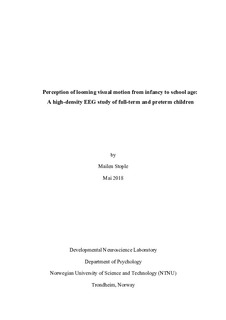| dc.description.abstract | By using high-density electroencephalogram (EEG), the present study investigated developmental trends in brain activity in response to looming visual motion from infancy to school-age in preterm children and their age- and gender-matched full-term peers. The children were tested at 4-5 months, 11-12 months, and at 6 years, where their looming-related brain responses were measured on a trials-by-trial basis. Analyses of looming-related visual evoked potentials (VEPs) revealed that the full-term children gradually decreased their VEP duration and time-to-collision with increasing age. The preterm children only decreased their VEP duration and time-to-collision from 11-12 months to 6 years, and showed significantly longer duration and time-to-collision at both 11-12 months and at 6 years compared to the full-term children. In addition, three preterm children were not able to switch to a more efficient timing-strategy based on the loom’s time-to-collision when timing their loomingrelated brain responses to the upcoming collision. Time-frequency analyses (TSEs) revealed that the full-term children showed shorter brain responses in higher frequency-bands with increasing age, while the preterm children showed their brain activity in the same duration and frequency-band during all three test sessions. In addition, the Movement Assessment Battery for Children (M-ABC) was included to investigate the children's motor function at 6 years. However, no differences between the full-term and preterm children could be observed in the motor domain. In sum, a clear developmental trend was observed in the full-term children's perception of looming visual motion, probably due to brain maturation and experience with self-produced locomotion. As the same developmental trend was not found in the preterm children, in addition to their worse performance compared to their full-term peers at both 11-12 months and 6 years, the developmental delay has been attributed to dorsal visual stream vulnerability related to preterm birth. Follow-up studies are therefore necessary to investigate if the preterm children will catch up with their full-term peers at a later age, or if they continue to show impaired perception of visual motion. | nb_NO |
